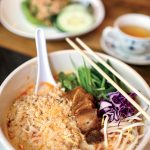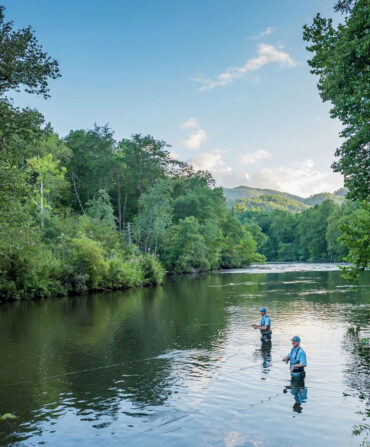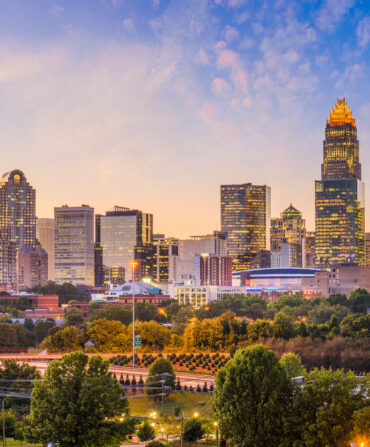Charlotte has its banks; Asheville, its beer; Durham, its Bulls. Raleigh’s thing, its calling card, has been tougher to pinpoint. At first glance, it’s a legislative city. The Greek Revival capitol building and various state and federal government offices occupy ample chunks of the concentrated downtown—and the state is still the city’s largest employer.
But half a mile southwest, across U.S. Highway 70, you’ll find a less buttoned-up identity emerging. Situated around the Warehouse District, a rising creative class is dominating local conversation. The up-and-coming neighborhood butts up to the railroad tracks, a proximity that historically made it prime real estate for icehouses, steel manufacturers, and freight depots. Today the area still celebrates those who make things; but in lieu of ice and steel, more and more it’s art and textiles.
Among the first in this contemporary wave of creatives to set up shop were the denim designers Victor Lytvinenko and Sarah Yarborough. The husband-and-wife team now occupy a 6,000-square-foot space in the heart of the Warehouse District that houses the factory where they produce their jeans line, Raleigh Denim Workshop, and their retail space, the Curatory. The enterprising duo isn’t the only company in town resurrecting the state’s storied textile history. Barton Strawn and Paul Connor started Lumina Clothing as a hobby in late 2009, making neckties mostly for friends. Now the company produces a full line of menswear, made in the United States, with a flagship store in Person Street Plaza—a stretch of small businesses located a few blocks northeast of the district. Nearby, international clothier Peter Millar staffs a large studio and design center at the restored Pilot Cotton Mill. “It’s a domino effect,” says Catherine Fain, who launched her women’s clothing line, Ramey Rhodes, in 2013. “I’ve lived here all my life, but it’s only been in the last few years that I’ve seen the growth and change to support this kind of field.”

Photo: Lissa Gotwals
Raleigh Denim Workshop owners Victor Lytvinenko and Sarah Yarborough.
Proof that one type of artistic energy feeds another, CAM Raleigh, the buzzed-about contemporary art museum, opened in 2011 around the corner from Raleigh Denim Workshop and has quickly become a North Star for the aesthetically inclined. The museum brought renewed life to the neighborhood art scene—home to an expanding network of galleries and artist collaboratives such as Antfarm Studios, where, for example,

Photo: Lissa Gotwals
Metalsmith Lucas House stokes the fires at Antfarm Studios in the Warehouse District.
blacksmith Lucas House forges large-scale sculptural metalworks such as a set of floating stairs for the recently revamped Nehi Bottling Company. CAM itself devotes all of its real estate to visiting exhibitions that bring in the best of what’s next—artists pushing established boundaries even in the famously freethinking realm of contemporary art. What’s more, it serves as a venue for some of the city’s most dynamic events—everything from CreativeMornings discussions moderated by local artists and entrepreneurs, to Wander Box, a pop-up beer garden built around a shipping container, to the newly minted Hopscotch Design festival. In its inaugural year, the festival pulled in such big names as Doug Powell, the former president of the American Institute of Graphic Arts, and Brian Singer, the design manager at the social media giant Pinterest.
“In Raleigh, design is viewed in broad terms,” says Hopscotch’s organizer, Matthew Muñoz, “giving people space to experiment, to try things out.”
People like Luke Buchanan. A painter by day, bartender by night, Buchanan has no trouble finding local outlets for his talents. He has painted murals such as the one for chef Ashley Christensen’s upcoming restaurant, Death & Taxes, as part of the Raleigh Murals Project, a grassroots effort to give the blank walls of the city’s industrial buildings a needed face-lift. He is also one of the organizers behind the recently launched Peregrine Projects, a collective of artists who set up roving events across the city. “We operate like a gallery without a brick-and-mortar,” Buchanan says. “Instead of moving somewhere with a bigger art scene, we’re building the community here.”
Raleigh’s young creatives aren’t starting with a blank canvas. It’s a reinvigoration of a tradition with deep roots in the city, planted by North Carolina State University’s School of Architecture and Landscape Design. The School of Design, as it became known, was founded in 1948; its first dean, Henry Kamphoefner, famously lured such architects as Frank Lloyd Wright and Buckminster Fuller to town, establishing new ideas about a modern Southern aesthetic. The school continues to attract talented art, design, and architecture students. The difference is, where they would once have departed for San Francisco or Chicago, more and more are staying put.
Joshua Gajownik, a graphic designer and NCSU design school graduate, is one of those who stayed. Last year, he participated in Rebrand Raleigh, a social-media-based project hosted by a local advertising agency to come up with a new city logo. Every two weeks, a different Raleigh artist took the helm of a dedicated Instagram account, documenting his or her creative process before unveiling a final design. Gajownik’s logo, built around sketches of oaks and pines, is a crescendo of green shapes that form the city skyline. Eleven local artists participated. Although the city hasn’t commissioned one for official use (yet), Gajownik, for one, is excited to see the arts community engaged in Raleigh’s future.
“There are still needs here,” he says. “In a town of Raleigh’s size, you have the ability to influence.”










